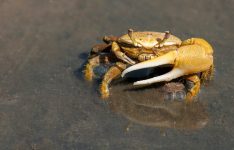Should Storing And Cooking Live Crustaceans Be Considered A Crime?

Australia produces about 230,000 tonnes of seafood per year and imports still more. It is a popular food all year round, even giving the Christmas turkey a run for its money.
You’ve probably been inside or at least walked past restaurants in which crustaceans are sitting in small, murky tanks, waiting to become lunch. In some places, crustaceans may be eaten while alive and writhing, or dropped into pots of boiling water, which kills them slowly. They may be stacked in small boxes, claws tied for days on end without relief.
Does this strike you as wrong?
Crustaceans don’t tend to fill us with the same warm, sentimental glow as bunny rabbits or fluffy chickens. But that is not the point.
Aptly put by one English legal philosopher in the late 1700s, Jeremy Bentham’s words still resonate with us today: “The question is not Can they reason? Can they talk? but can they suffer?”
Animal welfare, although it certainly receives more publicity these days, is not a modern invention; it was practiced by some ancient Greeks and Indians..
One example is the ancient Greek who you might be more familiar with as the guy who lent his name to the right-angled triangle you studied in maths class, but Pythagoras was also a vegetarian.
Crustaceans in New South Wales
While Australia has no universal animal laws, the NSW legislation does provide some protection against cruelty to animals.
Australia has no national laws against animal cruelty. The NSW Prevention of Cruelty to Animals Act 1979 states that an act of cruelty is one that is inflicted “unreasonably, unnecessarily or unjustifiably.”
A person may be guilty of it if at any time they:
- Themselves commit an act of cruelty upon an animal
- Fail to exercise reasonable care, control of supervision of an animal necessary to prevent the commission of an act of cruelty
- Fail to take reasonable steps to alleviate pain when it is being inflicted on an animal
- Fail to provide veterinary treatment for an animal where necessary
The penalties for animal cruelty are up to a $27,500 for companies or $5,500 for individuals, as well as a 6-month jail sentence. Aggravated cruelty could see a company fork out $110,000 and for an individual, the maximum penalty is $22,000 or two years in jail.
But despite these harsh penalties, animal cruelty continues to happen, usually in private until an animal activist group (with varying degrees of dubious legality) invade premises or farms to find proof.
Interestingly, in NSW, a crustacean is only classed as an animal when it is in a place where food is prepared for commercial consumption, and in some other states, it is not classed as an animal at all.
For many crustaceans, the cruelty begins when they are caught in nets, ripped out by careless fishermen, which wrenches away their legs or other extremities.
And this is not even covered by the above law, as they are not considered ‘animals’ (and therefore unprotected by legislation) until they reach the kitchen, restaurant or place where they are prepared for commercial consumption.
If they feel pain, what makes us think they can’t?
Many people don’t view current industry practices as cruel. This stems from a belief that fish and crustaceans don’t feel pain.
Recent studies have tremendously shaken up older notions that sea inhabitants are incapable of experiencing pain. Before then, most of us probably had vague notions that fish and other sea creatures don’t feel pain.
One of these studies involved injecting nasty chemicals into the lips of rainbow trout, who then stopped eating, rocked back and forth (both are also human behaviours for pain and shock) and behaved abnormally, by rubbing their mouths against gravel. When morphine was injected, the behaviour of the fish went back to normal.
Invertebrates, although making up about 95% of the animal kingdom, have often been dismissed as capable of feeling pain because their nervous systems are very different to ours. The smallest ones have no nervous systems so it is argued that their responses to stimulation are controlled by changes in the electrical activity of the cell, a response not due to pain.
Smaller invertebrates like bugs do not exhibit the same response to harmful stimuli that mammals do, but larger ones like cuttlefish, squid and octopi have much larger brains – the largest of all invertebrates can function in terms of sensory analysis, memory, learning and decision-making.
While research so far has proved far from universally conclusive, many do believe that crustaceans can feel pain, and the well-being of invertebrates is being taken increasingly seriously.
The RSPCA considers the evidence to be such that fish do feel pain and that crustaceans may be capable of experiencing pain and suffering.
The Australian National Code of Practice for Recreational and Sport Fishing was drafted in the 1990s, but without the consultation of any animal welfare groups.
The NSW Department of Primary Industries does not list a code of practice for crustaceans, but still worse, failure to comply exactly with those codes of animal treatment that do exist is not an offence according to the DPI.
However, the DPI does state that it is unacceptable to boil crustaceans alive before they have been chilled for at least 20 minutes, or to cut crabs into sections before destroying their front and rear nerve centres.
In NSW, restaurants are not allowed to sell animals so badly injured or distressed that it would be cruel to keep them alive. Premises must be clean and hygienic and animals must be protected from people, disease and distress. They must be adequately fed and housed without rapid temperature changes or water quality changes.
The RSPCA recommends, the least cruel methods of killing crustaceans should be employed – making them insensible through chilling, clove oil baths or electrical stunning.
They condemn the use of boiling live crustaceans or placing them in fresh water which causes them to die from severe osmotic shock, or serving any dish live.
While studies so far into the extent of pain felt by crustaceans are still in early stages, we do know there is a distinct possibility that the treatments sometimes inflicted on our marine-sourced meals will incur pain.
Making sure that cruelty to crustaceans is recognised is important, as is the need for us to recognise them as animals before they reach our plates.
As Dr Karl puts it, just because they may be cold-blooded animals, we don’t need to be cold-blooded killers.






